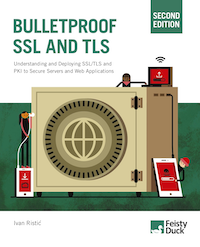RC4 in TLS is broken: Now what?
RC4 has long been considered problematic, but until very recently there was no known way to exploit the weaknesses. After the BEAST attack was disclosed in 2011, we—grudgingly—started using RC4 in order to avoid the vulnerable CBC suites in TLS 1.0 and earlier. This caused the usage of RC4 to increase, and some say that it now accounts for about 50% of all TLS traffic.
Last week, a group of researchers (Nadhem AlFardan, Dan Bernstein, Kenny Paterson, Bertram Poettering and Jacob Schuldt) announced significant advancements in the attacks against RC4, unveiling new weaknesses as well as new methods to exploit them. Matthew Green has a great overview on his blog, and here are the slides from the talk where the new issues were announced.
At the moment, the attack is not yet practical because it requires access to millions and possibly billions of copies of the same data encrypted using different keys. A browser would have to make that many connections to a server to give the attacker enough data. A possible exploitation path is to somehow instrument the browser to make a large number of connections, while a man in the middle is observing and recording the traffic.
We are still safe at the moment, but there is a tremendous incentive for researchers to improve the attacks on RC4, which means that we need to act swiftly.
What We (SSL Labs) Will Do
- Start warning our users about RC4 weaknesses. RC4 is demonstrably broken and unsafe to use in TLS as currently implemented. The difficulty is that, for public web sites that need to support a wide user base, there is practically nothing 100% secure they can use to replace RC4. We now have no choice but to accept that, no matter what settings we use, some segment of the user base will be at risk.
- If Apple were to implement 1/n-1 record splitting in their stacks (the only major browser vendor that hasn’t done that yet*), we’d likely consider BEAST sufficiently mitigated client-side, and that would allow us to start recommending CBC suites over RC4.
- Start recommending the use of GCM suites. Browsers will no doubt provide better support for TLS 1.2 and GCM suites at an accelerated schedule, and site operators should be ready to take advantage of that.
- Update SSL/TLS Deployment Best Practices with new information.
- At some point in the near future, update the rating algorithm to take the RC4 weaknesses into account.
Recommendations
SSL/TLS library developers
- Harden the stack against the Lucky 13 attack.
- Support TLS 1.2 and GCM suites as soon as possible.
Browser vendors
- Support TLS 1.2 and GCM suites as soon as possible.
- Implement 1/n-1 record splitting to make CBC suites safe in TLS 1.0 and earlier. As far as we are aware, Apple is the only remaining vendor that has not patched their browsers, either on OSX or iOS.
System administrators
- Disable TLS compression. This attack is similar in nature to the recent RC4 attacks, but practical.
- Support TLS 1.2 and GCM as soon as possible.
TLS Working Group
- Restore algorithm agility and diversity in TLS. AES GCM suites are now the only truly secure option in TLS, but we shouldn’t count on them to stay like that forever.
- Consider introducing other stream ciphers to the standard. Algorithm agility, which TLS already provides, is not sufficient if there is only one choice for a component.
- Consider changing how CBC is implemented in order to address the timing issues.
Application developers
- Harden session management to support reliable and frequent rotation of session cookies, triggered by elapsed time or the number of requests observed. Recent years have seen a rise in attacks that require attackers to control the client end of a TLS connection in some fashion. Most such attacks focus on extracting small bits of information, typically credentials. Session cookies are now the most popular target. Given how many requests are needed for the best attacks to succeed, rotating session cookies frequently is a good defense in depth measure.
(*) Apple appears to have shipped the 1/n-1 split in Mountain Lion, but it is disabled by default. I was also unable to observe any splitting after the functionality had been manually enabled. iOS devices should support TLS 1.2, which means that they might be secure provided TLS 1.2 is available server-side.
 |
MY BOOK: If you like this blog post, you will love Bulletproof TLS and PKI. For system administrators, developers, and IT security professionals, this book provides a comprehensive coverage of the ever-changing field of SSL/TLS and Internet PKI and will teach you everything you need to know to protect your systems from eavesdropping and impersonation attacks. It's available now. |


